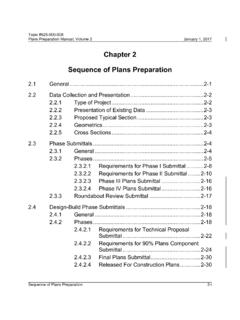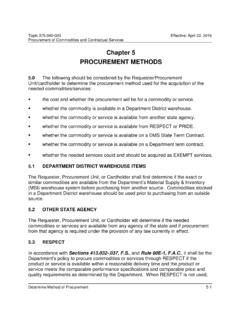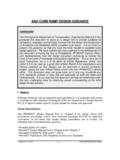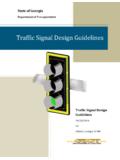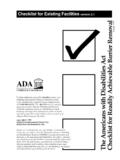Transcription of ADA* for Roadway Design
1 ADA* for Roadway Design Incorporating PROWAG**. * americans with disabilities act ** Public Rights of Way Accessibility Guidelines Dean Perkins, Architect ADA Coordinator Florida Department of Transportation Introduction Brief overview of ADA. How ADA impacts Roadway projects Features of Accessibility New Concepts Examples of Roadway elements Random images Some good; some not so good How you can comply Background of the ADA. 1990 americans with disabilities act July 26, 1990 - signed January 26, 1992 effective date July 1, 1994 Revised ADA Standards. July 26, 2004 new ADA guidelines (ADA/ABA).
2 Nov 23, 2005 new PROW guidelines (PROWAG). Nov 26, 2006 FHWA adopts ADA Standards for Transportation Facilities (ADASTF). July 23, 2011 Access Board issues NPRM for PROWAG. Latest News: Final Rule due out late 2016? USDOT adoption in early-mid 2017??? The Future of Facilities within Public Rights of Way(?). USDOT / FHWA recommends using PROWAG criteria where ADA Standards do not address an issue. RECOMMENDATION: Start learning PROWAG! Transportation . Roadside Accessibility Accessible Route Requirements (PROWAG Pedestrian Access Route). Widths Running slopes Cross Slopes Surfaces Changes in Level Gaps / Grates Protruding Objects Signs & Equipment, Landscape Materials, etc.
3 Accessible Route (AR) &. Pedestrian Access Route (PAR). AR = 36 continuous unobstructed path PAR = 48 (FDOT Stds. & PROWAG). AR = 32 min. at a point' (24 max.). PAR = 48 (FDOT Stds. & PROWAG). 60 x 60 passing space @ 200'. max. 24 . 32 . 48 Min. Min. Slopes: 1:20 ( 5%) is not a ramp >1:20 (>5%) is a ramp 1:12 ( ) max. allowed *. Cross-slope 1:50 (2%) max. allowed *. 1:75 ( ) best practice 48 Min. * Exceptions in PROWAG. Pedestrian Access Route (PAR). Continuous Width The minimum continuous and unobstructed clear width of a pedestrian access route shall be 4 ft., exclusive of the width of the curb Measure from back of curb!
4 4'. The Sidewalk Zone' System Curb Zone Furniture Zone Pedestrian Zone (PAR). Frontage Zone Zone System: Residential Furniture Pedestrian Zone Zone (PAR). Zone System: Commercial Street Parking Furniture Pedestrian Zone (PAR). Zone Furniture Zone Carefully arranged street furniture leaves the sidewalk clear Randomly arranged street furniture clutters the sidewalk and creates an obstacle course'. A difference between AR & PAR! For sidewalks within the public right of way .. Sidewalk grade ADASTF vs. PROWAG. ADASTF: Provide accessible route (AR). PROWAG: Match Roadway grade (PAR).
5 ADASTF PROWAG. Ramps supported slopes . , Bridges 5' min. 30' - 40' max. 5' min. Level means: Top/Interim Depending on slope (see Bottom Landing 2% or less slope Landing below). 30 Max. Sidewalks Are Pedestrian Access Routes (PAR). 48 min. width FDOT Design Standards Index 310. PROWAG Section R302. Cross-slopes 1:48 / 2% max. Check Surfaces Firm, Stable, Slip-resistant . Look for Level changes / . Look for Protruding Objects 27 -80 . (4' min.). (4' min.). Curb Ramps Running Slopes (1:12 / max.). Cross-slopes (1:48 / 2% max.). Landing at top (48 min.). Detectable Warnings X = 48 min.
6 12. Curb Ramp Grade R304. Least slope possible is preferred Recommended maximum grade to allow for construction tolerance Maximum grade Exception: when chasing grade, curb ramp length need not exceed 15', but slope must be uniform Up to 15'. Transportation . Curb Ramps and Detectable Warnings Curbs are an 'edge cue' for pedestrians who are blind or have low vision Curbs are a barrier for persons in wheelchairs Curb ramps remove the barrier for wheelchairs Curb ramps remove the edge cue for pedestrians with vision impairments Detectable warnings are a replacement cue to indicate location of the street Perpendicular Curb Ramps Perpendicular Curb Ramp Place DW at back of curb or at grade break Ramp 24.
7 Directional/Linear Ramps Greater than 5 feet setback .. Place DW on bottom landing if level landing is more than 5' deep at any point Ramp > 5'. Directional/Linear Ramps Equal to or less than 5 feet setback from bottom of curb ramp .. Place DW at grade break if level landing at bottom of ramp is 5' deep or less 5'. Ramp Parallel Ramps Ramp Ramp LANDING. 24 . Detectable warning = Stop sign'. Delineates the edge of the street Does replace missing edge cue ( , curb) for a pedestrian who is blind or visually impaired Does not designate the best place to cross Does not provide alignment information Detectable Warning Alignment To align or not to align.
8 Detectable warnings warn' of Roadway edge DW alignment generally NOT used as directional cue Other methods: traffic sounds, return curbs, APSs, etc. In a perfect world, all detectable warnings would be aligned with crossing Easier to construct Easier to use However .. Not all curb ramp configurations and site conditions permit DW alignment Detectable Warning Alignment To align or not to align .. So . Dome alignment is desirable, but not required Perfect World Real World Pedestrian Controls R306 & MUTCD In reach ranges (48 max.). 42 FDOT Standard 10 max. reach - over obstruction/edge of sidewalk 2 dia.
9 Raised buttons Maneuvering space (30 x 48 min., level). 3'-6 . Accessible Pedestrian Signals MUTCD For pedestrians with vision impairments Used in conjunction with pedestrian signal timing Add non-visual information: Tactile features Audible tones Vibrating surfaces Speech messages Must indicate which crossing is served by each device Accessible Pedestrian Signals Speakers Tactile Arrows Pushbutton Locations R403 & MUTCD 4E. NOTE: It must be clear which button controls which crossing. (per MUTCD). If APSs cannot be placed at least 10' apart, they must speak' to you. Pedestrian Crossings R306.
10 Cross Slope of crossing: STOP' or YIELD - controlled: 2% max. Traffic signal or no control: 5% max. Mid-block: Match grade of Roadway This is who we are working for RRFB. Rectangular Rapidly Flashing Beacon Upon activation of push button . HAWK. Pedestrian Hybrid Beacon Stays dark for vehicles and solid 'hand' for pedestrians until activated, then . For vehicles: 1. Flashing Yellow light, 2. Solid Yellow light, 3. Solid Red lights 4. Alternating Red lights, 5. Then dark For pedestrians: 1. Solid Hand, 2. Solid Hand, 3. Solid Walk, 4. Flashing Hand 5. Solid Hand Bus Stops R308.


